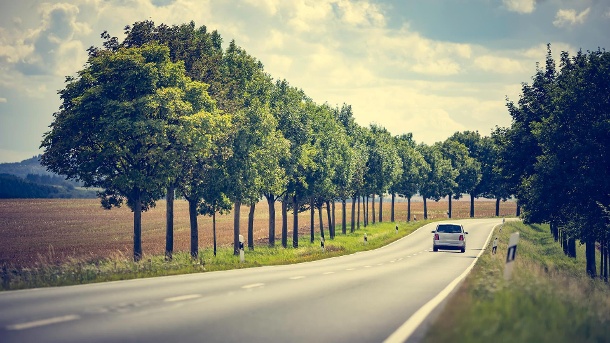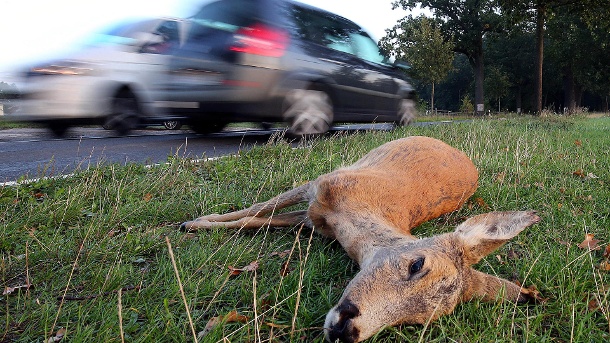Crossing deer, turning right or driving onto the autobahn: In everyday driving, there are situations with special risks. With these tips you will master the dangers.
Not paying attention for a moment - and a small everyday situation has already turned into a dangerous moment. Even getting out of the car is part of it: Is the way behind us really free? Or is a bike or a car coming? Everyone has probably forgotten to look backwards at some point. It's good if nothing happened then. But there is a simple trick that will keep you looking backwards in the future. You can find out here how you can prevent everyday hazards in traffic.
Always look over the shoulder
Looking over the shoulder when turning is often forgotten, but it is mandatory - at least twice. At blind intersections, you should turn around even more often so as not to overlook any cyclist. Even electronic assistants do not change that.
Always open the car door with the right
Suddenly the door opens: That can mean a risky situation for the flowing traffic. The exiting person is also at risk if he has not looked back beforehand.
You can avoid this danger with a simple means: Only open the driver's door with your right hand. Because you automatically look over the shoulder because you have to turn your head to the left.
Overtaking cyclists
Anyone who overtakes cyclists must keep a sufficient safety distance: a minimum of 1.50 meters applies for cars, from a speed of 90 and for trucks there is a minimum distance of two meters. If you cannot keep the distance, for example because of oncoming cars, you have to wait behind the cyclist for an opportunity. Otherwise there is a threat of being reported because of coercion or danger to traffic.
Driving onto the Autobahn
From the acceleration lane straight into the fast lane - this is very dangerous and can have legal consequences. When entering the autobahn, you first have to blend in with the normal-gauge traffic flow. In this way you can get an overview of the situation for yourself, and the other drivers can also adjust to you.
If you pull directly into the left lane instead, you not only risk a serious accident, you are also solely liable. Because judges will say: He acted negligently.

Overtaking on the country road only if visibility is 700 meters
Many accidents on country roads happen when overtaking because two distances are underestimated: the distance to oncoming traffic and the range of vision. You can only overtake safely if you have a visibility of at least 700 meters - that's equivalent to 14 delineator posts on the roadside.
It hardly makes sense anyway: Ideally, overtaking will save you ten percent of the driving time. For a distance of 20 kilometers, that's just a minute and a half.
Accident with wildlife: Drivers should always expect cruising game. But you can reduce the risk. (Source: dpa / tmn / Wolfgang Kumm) Wildlife accident: Drivers should always expect wild animals to cross. But you can reduce the risk. (Source: Wolfgang Kumm / dpa / tmn)

Avoid accidents involving wildlife
Not only with a deer crossing sign: Outside of cities and towns, always expect an animal to enter the road. Drive with the high beam at night as long as you do not disturb the oncoming traffic. This enables you to recognize wild animals at an early stage based on the light reflection of their eyes. If you spot wildlife on the side of the road, turn your headlights off.
If the traffic behind you is not endangered, brake and keep the steering wheel straight. Do not avoid the game if you could endanger yourself and oncoming traffic.
Driving in a traffic jam: There is no advantage in rushing into every gap - but it increases the risk of rear-end collisions. (Source: Getty Images / Westend61) Driving in a traffic jam: There is no advantage to rushing into every gap - but it increases the risk of rear-end collisions. (Source: Westend61 / Getty Images)
Don't use every gap in a traffic jam
No one enjoys traffic jams. Constantly changing lanes because a gap is just becoming free? In the end, you won't reach your goal any faster. On top of that, this is dangerous because you can quickly provoke a rear-end collision. Because in a traffic jam, the driver's attention is often close to a standstill. That is why the following applies to all motorists: Keep as calm as possible in traffic jams - and always think of the emergency lane.
Sit properly
Straight but relaxed: the seat position also determines your safety in the car. Some postures can lead to serious injuries in an emergency. You shouldn't sit too comfortably, but neither should you be too cramped.
Choose the seat height so that you have a good all-round view. A fist should fit between the head and the roof. The backrest is as upright as possible. When you press the pedals, your knee remains slightly bent, otherwise the seat is too far back. Otherwise, a frontal impact can lead to serious injuries, as the impact energy is passed on through the straight legs to the hips.
The headrest is adjusted as high as possible, but no more than the top of the head. Hold the steering wheel in approximately a quarter-to-three position with both hands with your arms bent. With your arm stretched out, you can reach the upper edge of the steering wheel rim with the ball of your hand.
When it comes to rumbling on vacation: Car accident abroad: how to behave properly
Starting problems in winter: four reasons why the battery runs out
Look what is blinking: What the warning lights in the car mean
Plasters, bandages and more: the best first aid kits for when you're on the go
The shoulders must keep contact with the backrest. Passengers should not put their feet on the dashboard, otherwise a deploying airbag could break their legs. In addition, the shoulder belt would strangle the passenger in the event of an accident. Heavy cargo belongs in the trunk near its rear wall.
